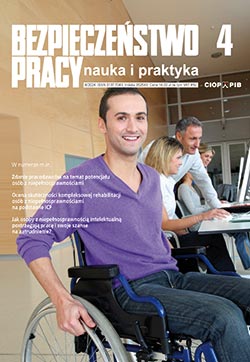The use of computer simulation in reconstructing accidents at work
Marcin Milanowicz, Paweł Budziszewski
Accidents at work are very common. They can result in a worker‘s serious injury or even death. The cause of an accident is often unknown, e.g., because of conflicting reports of eyewitnesses or because there were none. Knowing the course and cause of an accident at work may be very helpful in resolving controversies in a lawsuit. Prevention of similar situations is another advantage. CIOP-PIB studies the use of computer simulation in reconstructing accidents at work. Simulations make determining the probable cause of accidents possible.
Risk assessment in terms of heat stress in enclosed spaces
Anna Bogdan
This paper presents a method of risk assessment in enclosed spaces, it applies both to potential heat stress in hot environments and to thermal discomfort in moderate environments, as defined in PN-EN ISO 15265:2005. This standard can be used in any work environment in which the parameters of the air, the workers’ metabolic rate or the thermal insulation of their clothing have stable or time-varying values.
Life belt - an unsafe symbol of safety
Iwona Michniewicz, Romuald Michniewicz
A life belt is the most recognizable and firmly fixed symbol for assisting a drowning person. For years regulations that this device is the basic safety equipment at all swimming places have been copied (both in law and educational material for lifeguards). Tests have significantly changed the idealized image of the usefulness of a life belt especially in indoor swimming pools, water parks and small outdoor swimming pools. Not only do the parameters of this device (weight, type of material and shape) not guarantee the success of a rescue operation but indeed they are a great threat to the casualty and other swimmers.
Major accidents in road transport of dangerous materials (1) - predicting consequences
Jerzy S. Michalik, Agnieszka Gajek, Leszek Słomka
This paper presents sample results of computer simulations predicting potential consequences for people of accidents in road transport of dangerous materials. Hazardous toxic contamination areas resulting from a gasoline leak from a cistern have been predicted for uninhabited areas and areas of low- and high-density housing in winter and summer. The article discusses hazardous contamination areas resulting from an LPG leak from a cistern, from an LPG leak and fire, and from an explosion of LPG following a leak for the case of a road accident involving a cistern transporting LPG.
Occupational safety and health management and corporate social responsibility in the light of SA and ISO standards
Małgorzata Pęciłło
Corporate social responsibility (CSR) means voluntary incorporating environmental and social aspects that are beyond legal requirements into business activities of a company and its relationships with stakeholders. Increasing interests in this idea has been expressed in standards, e.g., Social Accountability 8000 standards and the ISO 26000 standard published in 2010. Stressing human factors in business activity is a key action within CSR. Meanwhile according to CIOP-PIB’s study on good practices, Polish enterprises seldom voluntarily incorporate elements of CSR in occupational safety and health into their practice.




























